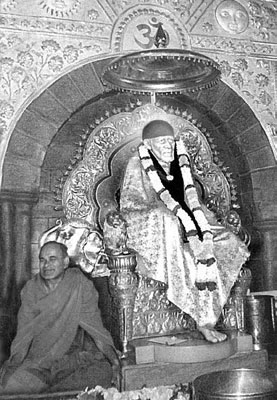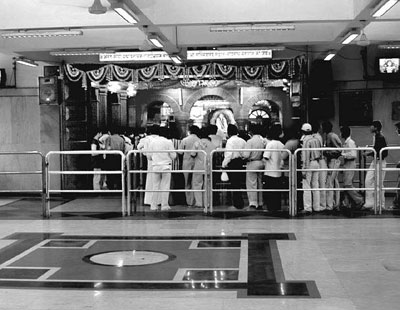
Baba repeatedly assured devotees that he would never cease to answer their call even from his tomb, and that his mission is "to give blessings". The pull of the tomb, above which the statue sits, is powerful and intense and draws seekers to Shirdi in numbers that increase every year. Here, devotees address their heartfelt prayers, beg for help, give thanks and offerings for prayers answered and wishes fulfilled, sing their devotion, and pay humble obeisance to their beloved deity. For them, the statue does not merely represent God, it is God; and the opportunity to prostrate before it and make oblations may be the fulfilment of a lifetime's ambition.
The statue, which has become such a famous and well-loved image of Baba, was not installed until 1954, and there is an intriguing story behind it. Some white marble arrived from Italy at the Bombay docks, but nobody seemed to know anything about it - who it was for, or why it had come. In the absence of a claimant, the dockyard auctioned it and the purchaser offered it to the Shirdi Sansthan (temple authorities). Impressed by the quality of the marble, they wanted to use it for an image of Baba and gave the commission to a sculptor from Bombay, Balaji Vasant Talim. However, the latter had only one black-and-white photo of Baba to use as his model and was struggling to get the likeness. One night Baba came to him in a dream, remarked on his difficulties and then showed him his face from various angles, encouraging Talim to study it thoroughly and remember it well. This gave Talim the fillip he needed and after that the work flowed easily and the result exceeded all expectations.


"My bones will assure you from my samadhi.
It will communicate with you.
It will respond to whoever surrenders to it."
After the first arati of the day, abhishekam (ritual bathing of the statue with water, milk, curd, ghee etc) is performed. Devotees may sponsor the abhishekam by contacting the Donation Office. Visitors may also donate cloth for Baba, which will be wrapped around the statue. Later, all the cloth that Baba has "worn" is put on sale in the Sansthan shop, just a few metres from the mandir. Many people like to buy cloth that has been sanctified in this way and use it for their altar or some other sacred purpose.
 Devotees queue for darshan inside the Samadhi Mandir
Believing that their work is service to a living Sai Baba, a living god, the priests carry out their duties with tender love and care. One of them related that once when bathing the statue, he inadvertently dropped the water container onto it.
Devotees queue for darshan inside the Samadhi Mandir
Believing that their work is service to a living Sai Baba, a living god, the priests carry out their duties with tender love and care. One of them related that once when bathing the statue, he inadvertently dropped the water container onto it.
For the next two days he had a severe pain in his knee, went to the doctor, had injections, took painkillers and did everything he could to try to alleviate it. Eventually he prayed to Baba and asked why he had to suffer in this way. That night Baba came to him in a dream and said, "You think you're in pain, but how do you think I felt when you dropped the jar?" Thereafter the priest was careful not to injure Baba in any way, and to respect the statue as if it were the living Baba in a physical body.
The feeling and experience that Baba is still alive and present pervades all the Sansthan facilities and activities of his devotees. As you move around Shirdi, you will see that this sentiment informs life, worship and pilgrimage here and contributes to the mystique and magic of what we call Shirdi.

For the next two days he had a severe pain in his knee, went to the doctor, had injections, took painkillers and did everything he could to try to alleviate it. Eventually he prayed to Baba and asked why he had to suffer in this way. That night Baba came to him in a dream and said, "You think you're in pain, but how do you think I felt when you dropped the jar?" Thereafter the priest was careful not to injure Baba in any way, and to respect the statue as if it were the living Baba in a physical body.
The feeling and experience that Baba is still alive and present pervades all the Sansthan facilities and activities of his devotees. As you move around Shirdi, you will see that this sentiment informs life, worship and pilgrimage here and contributes to the mystique and magic of what we call Shirdi.

No comments:
Post a Comment